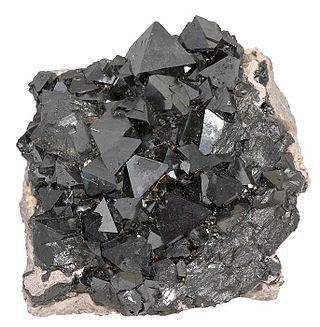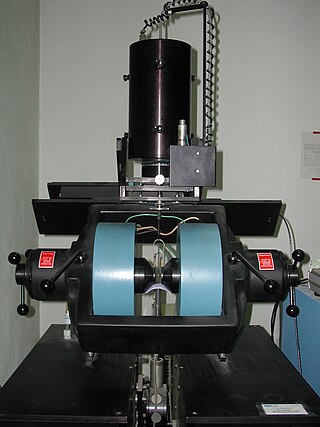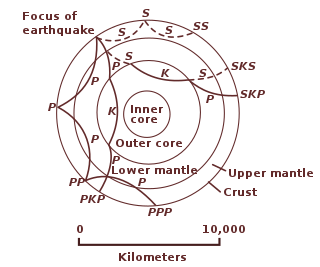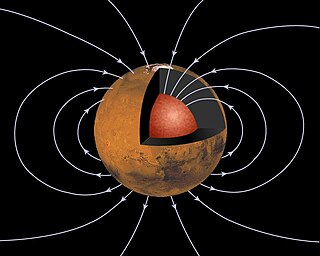Related Research Articles

Geophysics is a subject of natural science concerned with the physical processes and physical properties of the Earth and its surrounding space environment, and the use of quantitative methods for their analysis. Geophysicists, who usually study geophysics, physics, or one of the earth sciences at the graduate level, complete investigations across a wide range of scientific disciplines. The term geophysics classically refers to solid earth applications: Earth's shape; its gravitational, magnetic fields, and electromagnetic fields ; its internal structure and composition; its dynamics and their surface expression in plate tectonics, the generation of magmas, volcanism and rock formation. However, modern geophysics organizations and pure scientists use a broader definition that includes the water cycle including snow and ice; fluid dynamics of the oceans and the atmosphere; electricity and magnetism in the ionosphere and magnetosphere and solar-terrestrial physics; and analogous problems associated with the Moon and other planets.

Earth's magnetic field, also known as the geomagnetic field, is the magnetic field that extends from Earth's interior out into space, where it interacts with the solar wind, a stream of charged particles emanating from the Sun. The magnetic field is generated by electric currents due to the motion of convection currents of a mixture of molten iron and nickel in Earth's outer core: these convection currents are caused by heat escaping from the core, a natural process called a geodynamo.

Lodestones are naturally magnetized pieces of the mineral magnetite. They are naturally occurring magnets, which can attract iron. The property of magnetism was first discovered in antiquity through lodestones. Pieces of lodestone, suspended so they could turn, were the first magnetic compasses, and their importance to early navigation is indicated by the name lodestone, which in Middle English means "course stone" or "leading stone", from the now-obsolete meaning of lode as "journey, way".
Remanence or remanent magnetization or residual magnetism is the magnetization left behind in a ferromagnetic material after an external magnetic field is removed. Colloquially, when a magnet is "magnetized", it has remanence. The remanence of magnetic materials provides the magnetic memory in magnetic storage devices, and is used as a source of information on the past Earth's magnetic field in paleomagnetism. The word remanence is from remanent + -ence, meaning "that which remains".

Magnetite is a mineral and one of the main iron ores, with the chemical formula Fe2+Fe3+2O4. It is one of the oxides of iron, and is ferrimagnetic; it is attracted to a magnet and can be magnetized to become a permanent magnet itself. With the exception of extremely rare native iron deposits, it is the most magnetic of all the naturally occurring minerals on Earth. Naturally magnetized pieces of magnetite, called lodestone, will attract small pieces of iron, which is how ancient peoples first discovered the property of magnetism.

Paleomagnetism is the study of magnetic fields recorded in rocks, sediment, or archeological materials. Geophysicists who specialize in paleomagnetism are called paleomagnetists.

Rock magnetism is the study of the magnetic properties of rocks, sediments and soils. The field arose out of the need in paleomagnetism to understand how rocks record the Earth's magnetic field. This remanence is carried by minerals, particularly certain strongly magnetic minerals like magnetite. An understanding of remanence helps paleomagnetists to develop methods for measuring the ancient magnetic field and correct for effects like sediment compaction and metamorphism. Rock magnetic methods are used to get a more detailed picture of the source of the distinctive striped pattern in marine magnetic anomalies that provides important information on plate tectonics. They are also used to interpret terrestrial magnetic anomalies in magnetic surveys as well as the strong crustal magnetism on Mars.

In geophysics, a magnetic anomaly is a local variation in the Earth's magnetic field resulting from variations in the chemistry or magnetism of the rocks. Mapping of variation over an area is valuable in detecting structures obscured by overlying material. The magnetic variation in successive bands of ocean floor parallel with mid-ocean ridges was important evidence for seafloor spreading, a concept central to the theory of plate tectonics.

Magnetofossils are the fossil remains of magnetic particles produced by magnetotactic bacteria (magnetobacteria) and preserved in the geologic record. The oldest definitive magnetofossils formed of the mineral magnetite come from the Cretaceous chalk beds of southern England, while magnetofossil reports, not considered to be robust, extend on Earth to the 1.9-billion-year-old Gunflint Chert; they may include the four-billion-year-old Martian meteorite ALH84001.
Magnetostratigraphy is a geophysical correlation technique used to date sedimentary and volcanic sequences. The method works by collecting oriented samples at measured intervals throughout the section. The samples are analyzed to determine their characteristic remanent magnetization (ChRM), that is, the polarity of Earth's magnetic field at the time a stratum was deposited. This is possible because volcanic flows acquire a thermoremanent magnetization and sediments acquire a depositional remanent magnetization, both of which reflect the direction of the Earth's field at the time of formation. This technique is typically used to date sequences that generally lack fossils or interbedded igneous rock. It is particularly useful in high-resolution correlation of deep marine stratigraphy where it allowed the validation of the Vine–Matthews–Morley hypothesis related to the theory of plate tectonics.
Viscous remanent magnetization, also known as viscous magnetization, is remanence that is acquired by ferromagnetic materials by sitting in a magnetic field for some time. The natural remanent magnetization of an igneous rock can be altered by this process. This is generally an unwanted component and some form of stepwise demagnetization must be used to remove it.
Richard Doell was a distinguished American scientist known for developing the time scale for geomagnetic reversals with Allan V. Cox and Brent Dalrymple. This work was a major step in the development of plate tectonics. Doell shared the Vetlesen Prize with Cox and Dalrymple.
Plate reconstruction is the process of reconstructing the positions of tectonic plates relative to each other or to other reference frames, such as the Earth's magnetic field or groups of hotspots, in the geological past. This helps determine the shape and make-up of ancient supercontinents and provides a basis for paleogeographic reconstructions.
In electromagnetism, the Stoner–Wohlfarth model is a widely used model for the magnetization of ferromagnets with a single-domain. It is a simple example of magnetic hysteresis and is useful for modeling small magnetic particles in magnetic storage, biomagnetism, rock magnetism and paleomagnetism.
When an igneous rock cools, it acquires a thermoremanent magnetization (TRM) from the Earth's field. TRM can be much larger than it would be if exposed to the same field at room temperature. This remanence can also be very stable, lasting without significant change for millions of years. TRM is the main reason that paleomagnetists are able to deduce the direction and magnitude of the ancient Earth's field.

The following outline is provided as an overview of and topical guide to geophysics:

The history of geomagnetism is concerned with the history of the study of Earth's magnetic field. It encompasses the history of navigation using compasses, studies of the prehistoric magnetic field, and applications to plate tectonics.
The Koenigsberger ratio is the proportion of remanent magnetization relative to induced magnetization in natural rocks. It was first described by J.G. Koenigsberger. It is a dimensionless parameter often used in geophysical exploration to describe the magnetic characteristics of a geological body for help in interpreting magnetic anomaly patterns.

The magnetic field of Mars is the magnetic field generated from Mars' interior. Today, Mars does not have a global magnetic field. However, Mars did power an early dynamo that produced a strong magnetic field 4 billion years ago, comparable to Earth's present surface field. After the early dynamo ceased, a weak late dynamo was reactivated ~3.8 billion years ago. The distribution of Martian crustal magnetism is similar to the Martian dichotomy. Whereas the Martian northern lowlands are largely unmagnetized, the southern hemisphere possesses strong remanent magnetization, showing alternating stripes. Our understanding of the evolution of the magnetic field of Mars is based on the combination of satellite measurements and Martian ground-based magnetic data.
Subir Kumar Banerjee is an Indian-American geophysicist, known for research on rock magnetism, palaeomagnetism, and environmental magnetism.
References
- Dunlop, David J.; Özdemir, Özden (1997). Rock Magnetism: Fundamentals and Frontiers. Cambridge Univ. Press. ISBN 0-521-32514-5.
- Nagata, T (1989). "Natural remanent magnetization (NRM)". Geophysics. Encyclopedia of Earth Science. Springer US. pp. 855–857. doi:10.1007/0-387-30752-4_103. ISBN 978-0-387-30752-7.
- Nichols, Gary (1999). Sedimentology & Stratigraphy (1st ed.). Wiley-Blackwell. ISBN 978-0-632-03578-6.
- McElhinny, Michael W.; McFadden, Phillip L. (2000). Paleomagnetism: Continents and Oceans. Academic Press. ISBN 0-12-483355-1.
- Opdyke, Neil D.; Channell, James E.T. (1996). "Magnetic Stratigraphy". Introduction and History. International Geophysics. pp. 1–8. ISBN 9780125274708.
- ↑ Liu, Shuang; Fedi, Maurizio; Hu, Xiangyun; Baniamerian, Jamaledin; Wei, Bangshun; Zhang, Dalian; Zhu, Rixiang (2018). "Extracting Induced and Remanent Magnetizations From Magnetic Data Modeling". Journal of Geophysical Research: Solid Earth. 123 (11): 9290–9309.
- ↑ Opdyke, Neil D.; Channell, James E.T. (1996). "Introduction and History". International Geophysics. 64: 1–8.
- ↑ Singer, M.J.; Verosub, K.L. (2013). "Paleosols and Wind-Blown Sediments – Mineral Magnetic Analysis". Encyclopedia of Quaternary Science (Second Edition): 375–380.
- ↑ Gapeev, A.K.; Gribov, S.K.; Dunlop, D.J.; Özdemir, Ö; Shcherbakov, V.P. (May 1, 1991). "A direct comparison of the properties of CRM and VRM in the low-temperature oxidation of magnetite". Geophysical Journal International. 105 (2): 407–418.
- ↑ Pick, Thomas; Tauxe, Lisa (June 1, 1991). "Chemical remanent magnetization in synthetic magnetite". Journal of Geophysical Research: Solid Earth. 96 (B6): 9925–9936.